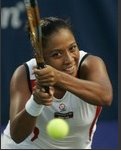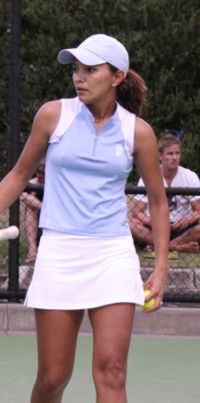Showing posts with label Nick Bollettieri. Show all posts
Welcome Tennis Lovers!!
...
Black History Month: Minority Tennis - A Historical Perspective, Part III
Friday, February 26, 2010
Part I - The Beginning
Part II The Emergence Of A Black Champion
PART III
THE THIRD GENERATION
THE THIRD GENERATION
 At the end of Althea’s career, Dr. Johnson realized that his dream of helping to produce a world champion was successful. But, he had something else up his sleeve… For the past several years, he had been grooming other talented youngsters at his home in Lynchburg, Virginia. Each summer, a group of the most talented minority youth from across the country would gather at his home to train and play tournaments. I was selected as the northeastern candidate and this is how I met the next world champion, Arthur Ashe. We were a talented group but it soon became clear that Arthur was something special. He was a quiet, determined youngster and was developing a formidable tennis game. In Dr. Johnson’s opinion, Arthur was perfect to lead the charge because he was unflappable. Insults, flagrant cheating and verbal abuse would roll off of Arthur’s back without effect. The mission was clear; win quietly and respond to nothing but the tennis ball. It was further made clear that any of us that reacted to the bad calls; any of us that argued; any of us that responded to the verbal slurs or challenged the fairness of the situation, would be sent home immediately. Although none of us were sent home for violations of these rules, those of us from the big, northern cities had to bite our tongues. Arthur, on the other had was born and raised in the segregated south. His father was the public park attendant at the tennis courts across the street from his home and he couldn’t play on those courts because he was black. He seemed to understand that he was destined for greatness and that his icy-cool demeanor was a key to success. We were made to understand that an outburst by one of us, would be seen as a negative characteristic of the entire group. Tournament directors would be able to say, “See, I knew they’d act that way if we let them into the tournament!” There were many youngsters placed in that situation over the years, but, none of us ever allowed those words to be uttered.
At the end of Althea’s career, Dr. Johnson realized that his dream of helping to produce a world champion was successful. But, he had something else up his sleeve… For the past several years, he had been grooming other talented youngsters at his home in Lynchburg, Virginia. Each summer, a group of the most talented minority youth from across the country would gather at his home to train and play tournaments. I was selected as the northeastern candidate and this is how I met the next world champion, Arthur Ashe. We were a talented group but it soon became clear that Arthur was something special. He was a quiet, determined youngster and was developing a formidable tennis game. In Dr. Johnson’s opinion, Arthur was perfect to lead the charge because he was unflappable. Insults, flagrant cheating and verbal abuse would roll off of Arthur’s back without effect. The mission was clear; win quietly and respond to nothing but the tennis ball. It was further made clear that any of us that reacted to the bad calls; any of us that argued; any of us that responded to the verbal slurs or challenged the fairness of the situation, would be sent home immediately. Although none of us were sent home for violations of these rules, those of us from the big, northern cities had to bite our tongues. Arthur, on the other had was born and raised in the segregated south. His father was the public park attendant at the tennis courts across the street from his home and he couldn’t play on those courts because he was black. He seemed to understand that he was destined for greatness and that his icy-cool demeanor was a key to success. We were made to understand that an outburst by one of us, would be seen as a negative characteristic of the entire group. Tournament directors would be able to say, “See, I knew they’d act that way if we let them into the tournament!” There were many youngsters placed in that situation over the years, but, none of us ever allowed those words to be uttered.After civil rights legislation was enacted in 1964, history would show that the black elite moved to exclusive, suburban communities. Some people believe that this suburban exodus was the beginning of the decline in the growth of black tennis as well as a slowing of the positive growth in the black community. Others believe that the ability to live beside and emulate positive role models, along with the forced creation of a homogeneous community, were positive aspects of segregation. Black businessmen, both legitimate and otherwise, were guaranteed to be successful - as a direct result of segregation. Any Black that opened a grocery store, produce stand or repair store was certain to capture the business of the local constituency, because those customers were not permitted to patronize white-owned stores. This environment provided fertile ground for entrepreneurs; legitimate businessmen and hustlers alike.
It is into this era that Arthur Ashe emerged as a standout tennis player. In some ways, Arthur was a most unlikely role model and world champion. He was slender, almost frail looking. He was mild-mannered; always appearing to be passive, unemotional and reserved. Did he possess the strength, focus and determination to overcome the alienation of segregation, along with the rejection and degradation that was sure to be in his future? Wouldn’t someone from the north - someone with a more aggressive personality - someone who would defy the system have a better chance to overcome the odds? History would show that Arthur was the perfect candidate. He was simply better than the rest of us. He was a likeable young man and if you were not a hard-core racist, you would find Arthur friendly, personable and non-confrontational. Even in his memoirs, “Days of Grace”, one can sense his absence of anger. Concerning his inability to play tournament tennis in his hometown of Richmond, Virginia, Arthur said: “I remember the kindly white tennis official, Sam Woods, who would not allow me to play in municipal tournaments in Richmond, and all the other not-so-kindly officials who barred my way so that I finally played in only one official tennis tournament while I was a junior in Virginia.”
His success as a Davis Cup player and his U.S. Open and Wimbledon titles are legendary. But, his recognition at tennis became the tool that he would use to challenge society to end the racial injustice that plagued the planet. He made several trips to South Africa (against the wishes of many Black leaders in America) to pressure the government to end apartheid. He marched on Washington in support of the fair treatment of Haitian refugees. His life was dedicated to the elevation of his people. He focused a great deal of his attention on education. He encouraged youngsters to become doctors and lawyers. He wanted youngsters to attend and graduate from college instead of putting all of their energy into athletics. He realized that less than 1% of varsity athletes ever signed a professional sports contract. At the same time, he made many attempts to create a system that produced a pipeline of young black players that could use tennis as a vehicle to take them to college. One such program was a collaboration with Nick Bollettieri. The Ashe-Bollettieri “Cities” Tennis Program (ABC) taught tennis to more than 10,000 children. The program attempted to impress upon them the value of preventive health education and the importance of staying in school. Hundreds from this program (which later became the Arthur Ashe Safe Passage Foundation) went on to college on either academic or athletic scholarships. It was one of the programs that made Arthur most proud. Before Arthur died, he got a glimpse of Venus and Serena Williams, two young girls that would, for a short time, take over the reins of leadership after his voice was silenced. But, Arthur would not live to see the emergence of James Blake. James possessed many qualities that would enamor him to the tennis community at large. He is handsome, articulate and Harvard University educated. More importantly, he is thoughtful, non-confrontational and non-threatening. James, if he is so inclined, will be the heir-apparent to Arthur’s throne; the voice of Black tennis. Because, you see, like Arthur, the voice of James Blake is the only one that is likely to resonate with the powers that be.
The author, Bob Davis, currently owns and operates Coastal Tennis and Sports, LLC in Bradenton, Florida.
Read the rest of this post...........
Posted by Shelia at 2:23 AM Labels: Althea Gibson, Arthur Ashe, Arthur Ashe Safe Passage Program, Bob Davis, Days of Grace, Dr. Robert Walter Johnson, James Blake, Nick Bollettieri, Sam Woods Email this post
Serena Williams Trains At Bollettieri Academy
Thursday, April 30, 2009
In preparation for the upcoming European clay court season, including the French Open starting May 24, Serena Williams today arrived at the Nick Bollettieri Tennis Academy/IMG Academies to train with Nick on the campus’ clay courts.
Williams, who is ranked No. 2 in the world, has worked with Nick in the past and wants to again find the magic on clay that led her to a French Open singles title in 2002.


Nick Bollateri's Tennis Academy Blog
Read the rest of this post...........
Posted by Shelia at 7:20 PM Labels: Nick Bollettieri, Nick Bollettieri Tennis Academy/IMG Academies, Serena Williams Email this post
Subscribe to:
Comments (Atom)


















































































![Validate my Atom 1.0 feed [Valid Atom 1.0]](valid-atom.png)
